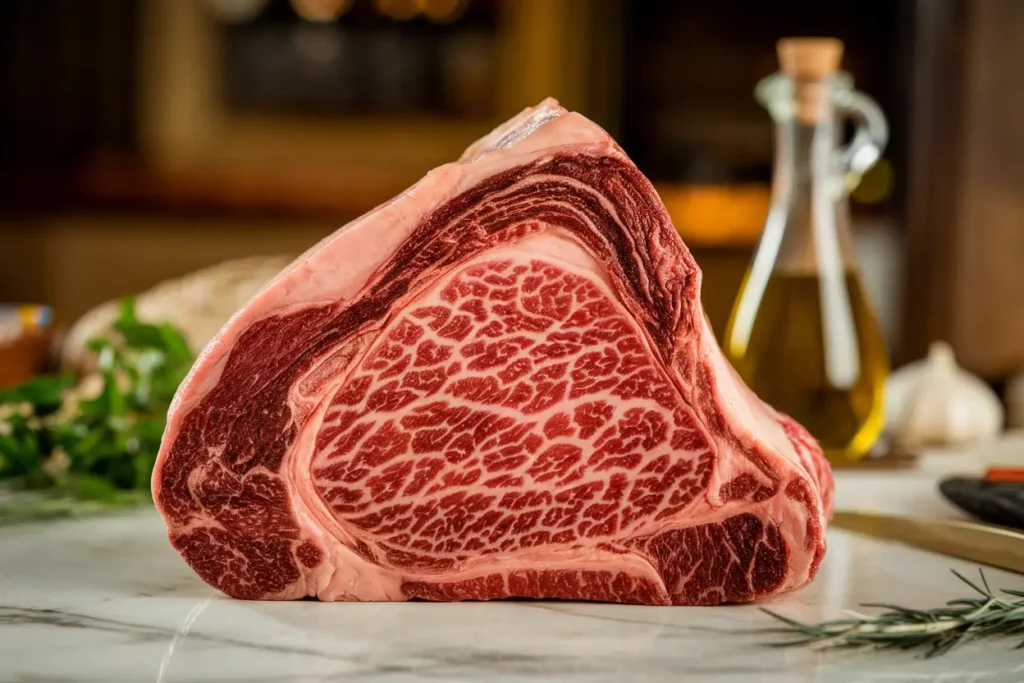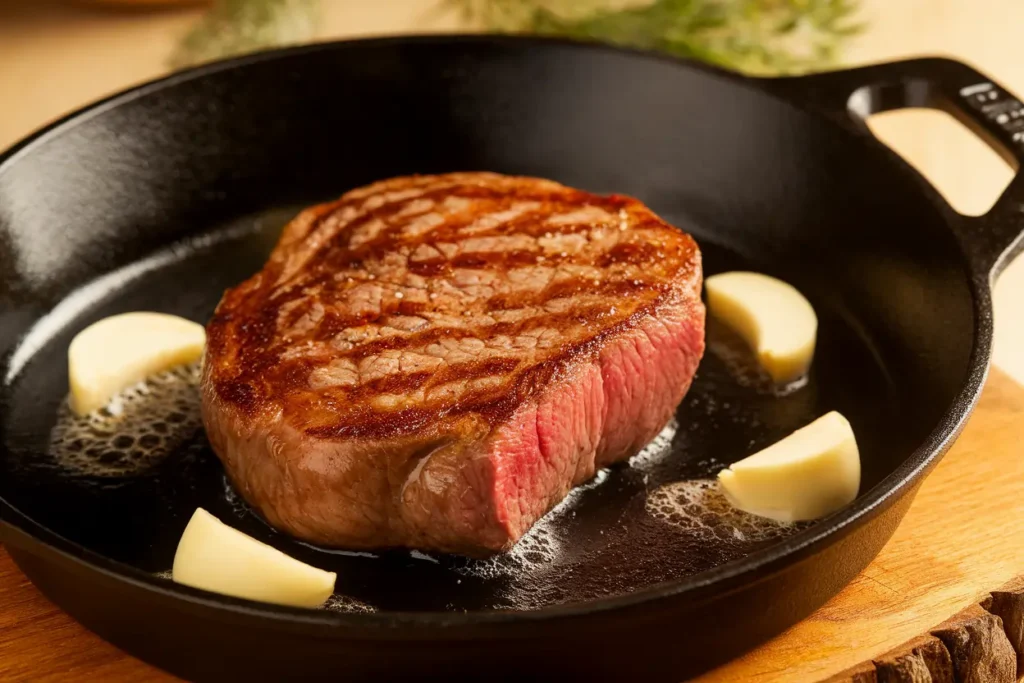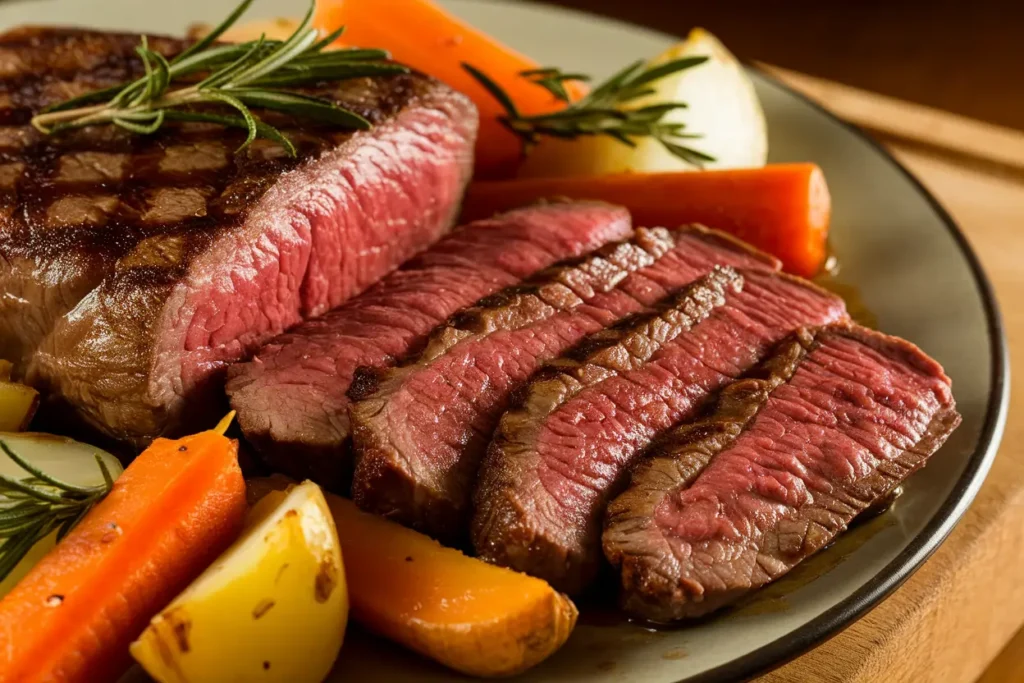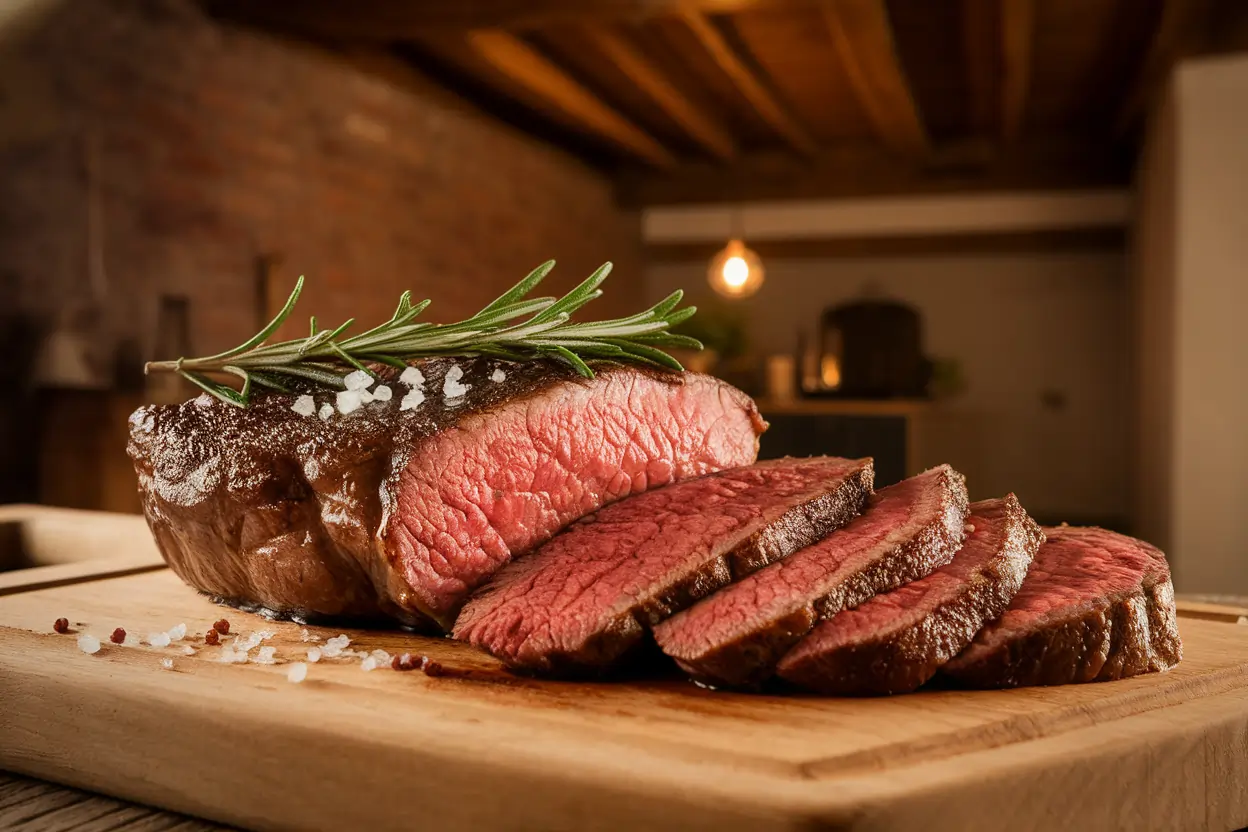Understanding Wagyu Zabuton Steak

If you’re wondering how to cook Wagyu Zabuton steak to perfection, you’ve come to the right place. This guide walks you through every detail, from understanding the unique characteristics of Wagyu Zabuton to preparing and cooking it like a pro. Whether you’re a beginner or an experienced chef, these tips and tricks will help you create a steak that’s tender, juicy, and bursting with flavor.
Table of Contents
What is Wagyu Zabuton Steak?
Ever heard of a steak that’s so buttery it melts in your mouth? That’s Wagyu Zabuton steak for you. The word “Zabuton” is Japanese for “cushion,” and honestly, this cut lives up to its name. It’s a slice of heaven carved from the chuck of the cow, known for its beautiful marbling, tender texture, and rich flavor. Think of it as the steak equivalent of a fluffy pillow—soft, indulgent, and oh-so-comforting.
Unique Characteristics of Zabuton Steak
What makes Zabuton stand out? The marbling. Those intricate white streaks of fat running through the meat are like nature’s artwork. They’re what give this steak its iconic juiciness and flavor. Plus, Zabuton is versatile—it can be grilled, pan-seared, or even cooked sous vide. Whether you’re a beginner or a pro, this cut is forgiving and rewards you with unmatched taste.
“Cooking a Wagyu Zabuton steak is like painting a masterpiece—it’s all about the details and the patience.”
Why is Wagyu Zabuton Considered a Delicacy?
Wagyu beef, including the Zabuton cut, comes from a breed of cattle raised with meticulous care. These cows are pampered like royalty, with a diet and lifestyle that ensure superior quality meat. The result? A steak that’s worth every penny. When you bite into a Wagyu Zabuton, you’re not just eating meat—you’re savoring a piece of culinary art.
Choosing the Perfect Wagyu Zabuton Steak
Grading Systems for Wagyu Beef
Not all Wagyu is created equal. When shopping for Zabuton, look for grading labels like A5, which is the highest quality. The “A” refers to yield (how much usable meat you get), and the number (1 to 5) represents marbling, color, and texture. A5 means top-notch marbling, deep color, and a texture so tender it’s almost magical.
How to Identify Quality Zabuton Cuts
A good Zabuton steak should have a deep, vibrant red color with lots of white marbling. Avoid cuts that look dull or have an uneven distribution of fat. Trust your butcher or supplier; a reputable source is key to getting the best steak.
Where to Buy Authentic Wagyu Zabuton Steak
Looking for the real deal? High-end grocery stores, specialty meat markets, or online Wagyu suppliers are your best bet. Just make sure the steak is certified Wagyu, and don’t be afraid to ask questions. Investing in a quality cut makes all the difference.
Preparing Wagyu Zabuton Steak for Cooking
Essential Tools for Cooking Zabuton Steak
Before you get started, make sure your kitchen is stocked with the right tools. Here’s what you’ll need:
- A cast-iron skillet or grill
- A meat thermometer
- High-quality tongs
- Sharp knife for precise slicing
Why a cast-iron skillet? It retains heat like a champ, ensuring a perfect sear. And the thermometer? It’s your best friend for nailing the ideal doneness.
The Importance of Proper Thawing
If your Wagyu Zabuton is frozen, thaw it properly—this is a non-negotiable step. Place it in the fridge for 24 hours. Need it faster? Use a cold water bath, but never microwave it. Quick thawing can mess up the texture, and you don’t want that!
Seasoning Techniques for Wagyu Zabuton
Less is more when it comes to seasoning. The natural flavor of Wagyu is the star, so stick to simple ingredients:
| Ingredient | Quantity |
|---|---|
| Sea salt | 1 tsp per side |
| Freshly ground black pepper | To taste |
| Olive oil | 1 tbsp |
Pro Tip: Season just before cooking to avoid drawing out too much moisture.
“A sprinkle of salt and pepper is all you need to let the natural flavors of Wagyu shine.”
Best Cooking Methods for Wagyu Zabuton Steak

Mastering how to cook Wagyu Zabuton steak starts with choosing the right cooking method. Whether you prefer pan-searing, grilling, or sous vide, each method enhances the steak’s natural flavors and ensures a perfect outcome. Let’s dive into the details.
Pan-Searing for a Perfect Crust
Pan-searing is one of the simplest yet most effective ways to cook a Wagyu Zabuton steak. Why? Because it creates a beautiful, caramelized crust while keeping the inside tender and juicy. Here’s how you do it:
- Heat a cast-iron skillet over medium-high heat until it’s smoking hot.
- Add a tablespoon of olive oil or clarified butter. Wait for it to shimmer.
- Place the steak in the pan and let it sear for about 2-3 minutes per side. Don’t poke, prod, or flip it too often—let it work its magic!
- Once it’s beautifully browned, reduce the heat to medium and cook until the internal temperature reaches your desired doneness.
“Pro Tip: For medium-rare perfection, aim for an internal temperature of 130°F (54°C). Use a meat thermometer for precision.”
Grilling Wagyu Zabuton to Perfection
If you’re craving that smoky, charred flavor, grilling is your go-to method. But remember, this isn’t your average steak, so treat it gently. Here’s a step-by-step guide:
- Preheat your grill to high heat, ensuring it’s clean and oiled to prevent sticking.
- Season the steak lightly with salt and pepper, then brush it with a bit of olive oil.
- Place the steak directly over the flames and grill for about 2 minutes per side for a nice char.
- Move the steak to indirect heat and cook until it reaches the desired doneness.
Always rest the steak for 5-10 minutes after grilling. This allows the juices to redistribute, giving you a melt-in-your-mouth bite every time.
Sous Vide: Precision Cooking for Zabuton Steak
Sous vide is a game-changer, especially if you’re nervous about overcooking. It’s like having a personal chef control the temperature for you. Here’s how it works:
- Set your sous vide machine to 130°F (54°C) for medium-rare.
- Season the steak and place it in a vacuum-sealed bag.
- Submerge the bag in the water bath and let it cook for 1-2 hours.
- Once done, sear the steak in a hot skillet for 30 seconds on each side to develop a crust.
The result? A steak that’s evenly cooked from edge to edge with a perfect crust on the outside. Magic!
Common Mistakes to Avoid When Cooking Zabuton Steak
Overcooking: The Biggest Mistake
Overcooking is a common issue when learning how to cook Wagyu Zabuton steak. The delicate marbling and fat of Wagyu require precise heat control. Stick to medium-rare for the best texture and flavor, and always use a meat thermometer to avoid mistakes.
Overcooking: The Biggest Mistake
Wagyu is all about that luxurious fat, and overcooking can ruin it. If you cook it past medium, you risk losing that melt-in-your-mouth experience. Stick to medium-rare or medium at most.
Skipping Resting Time
Picture this: you’ve cooked the perfect steak, but when you cut into it, the juices run all over the plate. Resting the steak for a few minutes helps the juices stay locked in. Trust me, patience pays off!
Using the Wrong Cooking Oil or Tools
Wagyu has a low smoke point due to its high fat content, so using the wrong oil can lead to a smoky mess. Stick to oils with high smoke points, like avocado or grapeseed oil, for the best results.
Tips for Achieving Restaurant-Quality Results
Monitoring Internal Temperature
This isn’t the time to eyeball it. Use a meat thermometer to ensure you hit the perfect doneness. Here’s a quick guide:
| Doneness Level | Internal Temperature |
|---|---|
| Rare | 120°F (49°C) |
| Medium Rare | 130°F (54°C) |
| Medium | 140°F (60°C) |
Pairing Wagyu Zabuton with Side Dishes and Sauces
What’s a steak without sides? Pair your Zabuton with roasted vegetables, creamy mashed potatoes, or a crisp salad. For sauces, stick to classics like béarnaise, chimichurri, or a simple red wine reduction. The idea is to complement the steak, not overpower it.
Plating and Presentation Tips

First impressions matter! Slice the steak against the grain for maximum tenderness and arrange it neatly on the plate. Garnish with fresh herbs or a sprinkle of sea salt for that Instagram-worthy finish.
“A well-plated Wagyu steak isn’t just food—it’s a work of art.”
Solving Common Problems When Cooking Wagyu Zabuton
Dealing with Uneven Cooking
Struggling with one side cooking faster than the other? It happens! The solution? Make sure the steak is at room temperature before cooking. A cold steak straight from the fridge won’t cook evenly. Also, rotate the steak and adjust the heat if necessary.
Preventing Excess Smoke While Cooking
Cooking Wagyu can produce more smoke due to its high-fat content. To prevent your kitchen from looking like a scene out of a disaster movie, use a splatter screen and ventilate the area. Also, avoid overheating the pan—medium heat is your friend!
Maintaining the Juiciness of the Steak
Nobody likes a dry steak, especially when it’s Wagyu. To keep it juicy, avoid overcooking and always let the steak rest before slicing. If you’re grilling, baste the steak with its rendered fat for an extra layer of moisture and flavor.
Frequently Asked Questions About Wagyu Zabuton Steak
Can I Cook Zabuton Steak in a Regular Pan?
Absolutely! While a cast-iron skillet is ideal, a high-quality non-stick or stainless steel pan works too. Just make sure it’s properly heated to achieve that golden crust.
How Do I Store Leftover Wagyu Steak?
Got leftovers? Wrap the steak tightly in foil or place it in an airtight container. Store it in the fridge for up to 3 days. When reheating, use low heat to preserve its tenderness—microwaving is a no-go!
Is Wagyu Zabuton Suitable for Beginners?
Definitely! Despite its luxurious reputation, Zabuton is relatively easy to cook. Just follow the basic guidelines—don’t overcook, use simple seasoning, and handle it with care. Even beginners can master it with a bit of practice.
Health Benefits and Nutritional Value of Wagyu Zabuton Steak
Wagyu Zabuton steak isn’t just delicious; it’s surprisingly nutritious too. Check out the nutritional breakdown:
| Nutrient | Per 4 oz (113g) |
|---|---|
| Calories | 320 |
| Protein | 22g |
| Fat | 26g |
| Saturated Fat | 10g |
| Iron | 15% DV |
Thanks to its high levels of monounsaturated fats, Wagyu is actually a healthier choice compared to regular beef. It’s packed with essential nutrients like iron and protein, making it a guilt-free indulgence.
If you’re curious to dive deeper into the world of Zabuton steak, we’ve got you covered! Start by exploring our ultimate guide to Zabuton steak, where you’ll find expert cooking tips and frequently asked questions. Wondering what makes this cut special? Check out what cut of steak is Zabuton—a quick guide to understand its origins and characteristics. For those still asking, “Is Zabuton a good steak?” we’ve detailed its unique qualities and why it’s a must-try in this comprehensive article. Lastly, don’t miss our complete guide to this tender cut, perfect for anyone wanting to master the art of preparing this flavorful steak.
Conclusion: Mastering the Art of Cooking Wagyu Zabuton Steak
Final Thoughts on Cooking Wagyu Zabuton
Final Thoughts on Cooking Wagyu Zabuton
Learning how to cook Wagyu Zabuton steak is an art, but with practice, you’ll be serving up restaurant-quality meals in no time. This steak is all about simplicity and precision, so focus on highlighting its natural flavors.
Cooking Wagyu Zabuton steak isn’t just about making a meal—it’s about creating an experience. With its rich marbling, melt-in-your-mouth texture, and luxurious flavor, this steak is worth every ounce of effort. Whether you’re pan-searing, grilling, or going all out with sous vide, remember that patience and care are the keys to success.
Encouragement to Experiment and Enjoy
Don’t be afraid to get creative. Try different seasonings, pairings, and cooking methods to find your perfect recipe. Cooking is as much about experimenting as it is about following rules. So grab that Wagyu Zabuton, fire up your kitchen, and let your culinary adventure begin!
“Wagyu Zabuton steak isn’t just food—it’s a celebration of flavor. Treat it with respect, and it will reward you tenfold.”
Happy cooking! 🥩✨

